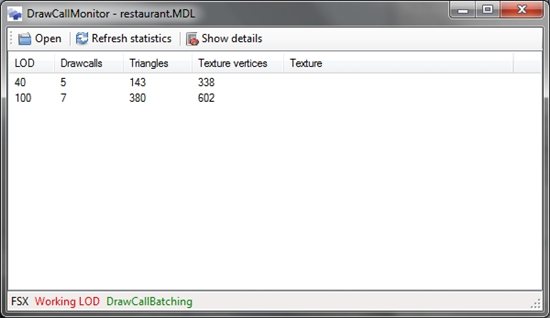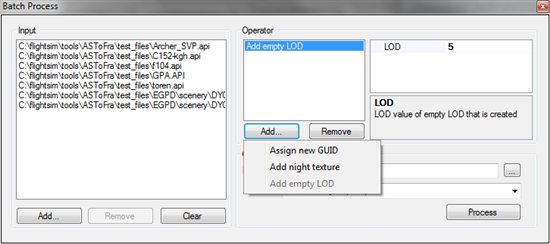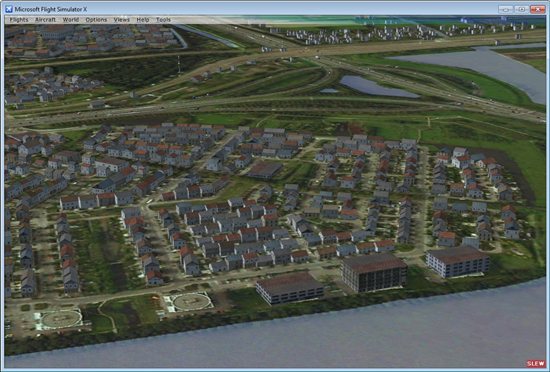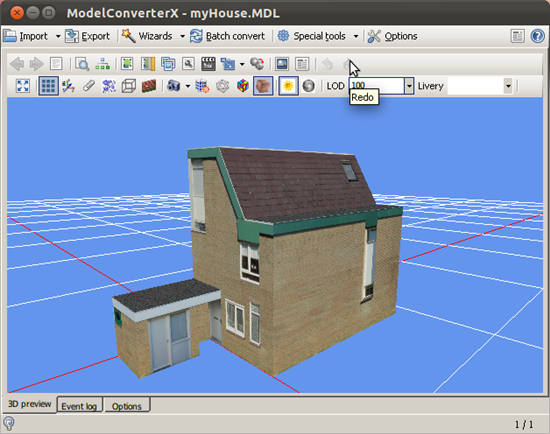I have just made a small update to the DrawCallMonitor tool. The change is that the user interface now has a status bar that will show you some additional information. The two main things are does this object have drawcall batching and does it have working levels of details. These two are related, but with this update you can quickly see how your object will perform. If the levels of details will not work, the text is red, if they will the text is green. Similar for the drawcall batching.
Quite some news
I haven’t posted much to this blog recently, because some other things kept me busy. Had a business trip for work, spend some time preparing for the Sinterklaas celebration tradition we have in the Netherlands, etc. But there has been quite some exiting news recently that I want to share with you all.
Flight beta
Microsoft has announced that the beta testing of Microsoft Flight will start next month. That’s interesting news, let’s hope it will be a good platform for addon developers again. The even better news is that you can apply now to be part of the beta testing. So if you want to help removing some bugs and making it a better simulator this is your chance.
SketchUp update
Google has announced an update for SketchUp. Two things from the announcement seem especially interesting for FS developers using SketchUp. The first is that the COLLADA exporter has been improved to be more compliant with the standard. I am going to test soon if ModelConverterX can still process the current output correctly. Another interesting improvement is that the filenames are now preserved when exporting. I think that could help FS developers a lot, since that would mean you don’t have to rename those texture0, texture1, etc all the time.
X-Plane
A demo version of X-Plane 10 has been released and the official release is scheduled within a few days. I haven’t tried the demo yet, but from the screenshots it looks like a very interesting platform. I am a little surprised it was release so quickly after the FSWeekend, since the demo we saw there was not so stable yet. Reading on the internet it seems the demo also got some mixed reactions. Especially this announcement on their blog tells me I probably better wait a few more patches before I start exploring making addons for X-Plane 10.
Library Creator XML 3.0 beta available
A first release of the new Library Creator XML 3.0 is now available, you can get it as part of the development releases of my tools. The main changes are in the user interface, I hope the tool is even easier to use. Another reason for the changes is that with the changes I made now it will be easier to add new features in the future. One feature high on my list is being able to import a library from BGL. So that will come in a future update. I made a quick video to illustrate the new version:
New batch convert user interface available
The updated batch convert user interface, I blogged about earlier this week, is now available in the development release of ModelConverterX. And what better way to demonstrate it, than with a video tutorial:
Updating the batch functionality
In the last week or so I got two requests to make small modifications to the batch convert functionality of ModelConverterX. But instead of just making these small changes, I have decided to give this functionality a bigger update (that was something I had in mind already). My goal is to make the batch convert more flexible. With the new user interface, of a which a screenshot is shown below, you will get the following extra functionality:
- Ability to process input files from different folders.
- Add operators to perform additional actions on the object being converted. An example of this can be adding an empty LOD, adding a night texture to each material or changing the GUID. I will design this functionality so that I can very easily add additional actions in the future as well.
Let me know if there are more ideas to improve the batch functionality, I might be able to include them with this update.
FSWeekend wrap-up
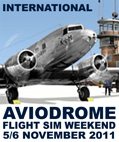 So this weekend was the annual FSWeekend in the Netherlands again. Just like the last couple of years I was present again at the NL2000 and FSDeveloper booth. It is always amazing to see in how many ways people can enjoy their flight simulation hobby. It ranges from flying in clubs to building cockpits at home, making addons and much more. And this weekend is not only about Microsoft Flight Simulator, Falcon 4, X-Plane and FlightGear were also well represented again.
So this weekend was the annual FSWeekend in the Netherlands again. Just like the last couple of years I was present again at the NL2000 and FSDeveloper booth. It is always amazing to see in how many ways people can enjoy their flight simulation hobby. It ranges from flying in clubs to building cockpits at home, making addons and much more. And this weekend is not only about Microsoft Flight Simulator, Falcon 4, X-Plane and FlightGear were also well represented again.
The best part of the event is probably talking to all the visitors. After so much online contact, it is nice to see the face behind the forum name. Especially at the NL2000 stand we always get a lot of questions from our users.
On the Saturday I gave a presentation together with Francois Dumas about using SketchUp to model to FS. We got a nice crowd in the room and hopefully we have inspired some people to start building their own house. It’s fun to do.
On the Sunday there were some other interesting presentation as well. First from FlightGear. Unfortunately this one did not attract such a big audience, but it was really interesting to see how this simulator has grown over the years. Maybe visually not at the level of some of the other platforms yet, but the fact that it is open source and completely community driven gives this simulator a special place for sure.
The final presentation was from Austin Meyer about X-Plane 10. Some of the features in the scenery really look impressive. It’s a pity the simulation hang a couple of times during the demonstration. If they really want to hit their Christmas release some work still has to be done, but he mentioned the beta only started recently. I asked about their development tools and SDK, from the answer it seems these are not so mature yet. Hopefully we get some more information about this soon, since I am very interested to see what kind of platform X-Plane 10 can become for addon developers. For sure I will be keeping an eye on it and will try to add some more support in my tools for this simulation as well.
txt2agn
Some weeks ago I added a tool called agn2txt to the development release package of my tools. With this tool you can decompile AGN files to readable TXT files. Today I have added the reverse tool as well. As you might have guessed it is called txt2agn and it can be used to compile the TXT file form agn2txt back into an AGN file. So this allows you to make changes to the TXT file and then create an updated AGN file.
The tool is a command line application again and it takes two arguments. The first is the TXT file to compile and the second is the folder in which the AGN file should be created.
Since this is a first beta release there might be some bugs left. Please let me know if you run into trouble with it.
FSWeekend presentations
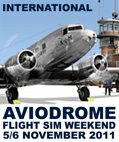 I made a mistake in my last blog post about our SketchUp presentation at FSWeekend. We will not be giving this presentation on both days, but only on the Saturday. On the Sunday there are some other interesting presentations. Below is the complete schedule of all presentations. Hope to see you there!
I made a mistake in my last blog post about our SketchUp presentation at FSWeekend. We will not be giving this presentation on both days, but only on the Saturday. On the Sunday there are some other interesting presentations. Below is the complete schedule of all presentations. Hope to see you there!
Saturday
11:00 – 12:00 – Geert Rolf – Rebuilding a real Flight Simulator, an overview of 3 years work at the Norwegian DC-10 (in English)
13:00 – 14:00 – Joop Mak – The history and development of the NL2000 scenery (in Dutch)
15:00 – 16:00 – Arno Gerretsen and Francois Dumas – Build your own house with SketchUp (in Dutch)
Sunday
11:00 – 12:00 – Joop Mak – The history and development of the NL2000 scenery (in Dutch)
13:00 – 14:00 – Durk Talsma – FlightGear (in Dutch)
15:00 – 16:00 – Austin Meyers – X-Plane 10 (in English)
scenProc improved filtering
Today I have extended the filtering options in scenProc. I have added some addition parameters and allowed different conditions. The new attributes are the length, width and area of the feature. These are calculated and added as attributes for each feature now. The new conditions mean that you can now also filter on attributes being not equal, greater or smaller than the given value.
An example where I used such conditions is below. In that case I gave all buildings with a width below a certain value a peaked roof, while I gave all wider buildings a flat roof. With this I hope to get a better representation of big buildings, since they are more likely to be industrial buildings or for example schools. Just buildings more likely have a flat roof.
The image shows the result is still not perfect, but it is getting better. I’ll be doing some more experimentation to determine how to filter the footprints and determine more realistic autogen building types.
ModelConverterX on Linux
Yesterday I updated my Linux machine to the latest version of Ubuntu. One of the components that was updated along the way was Wine. So this morning I decided to try to start ModelConverterX using Wine. I had tried this before, but then it resulted in a crash as far as I remember, because one of the DLL files tried to access a Windows specific function. But, slightly to my surprise, ModelConverterX now ran fine. Below you see a screenshot of the tool in action on Ubuntu, loading a FSX MDL file.
I think it is good news the tools runs on Linux as well, for example for developers who want to convert some of their MSFS work to FlightGear or the other way around.
 SceneryDesign.org
SceneryDesign.org 